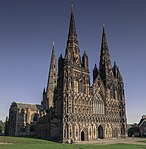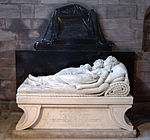Minster Pool
AC with 0 elementsLichfieldReservoirs in StaffordshireUse British English from August 2013

Minster Pool is a reservoir located between Bird Street and Dam Street in the heart of the city of Lichfield, Staffordshire in the United Kingdom. The pool lies directly south of Lichfield Cathedral and historically has been important to the defence of the Cathedral Close. The pool was originally formed in the 11th century when a boggy stream was dammed at its eastern end to drive a mill on Dam Street. The pool was used as a mill pond and fishery until 1856 when the mill was demolished; it has since been retained for public amenity.
Excerpt from the Wikipedia article Minster Pool (License: CC BY-SA 3.0, Authors, Images).Minster Pool
Pool Walk, Lichfield Dimbles
Geographical coordinates (GPS) Address Nearby Places Show on map
Geographical coordinates (GPS)
| Latitude | Longitude |
|---|---|
| N 52.684293 ° | E -1.829972 ° |
Address
Remembrance Garden
Pool Walk
WS13 6QT Lichfield, Dimbles
England, United Kingdom
Open on Google Maps









